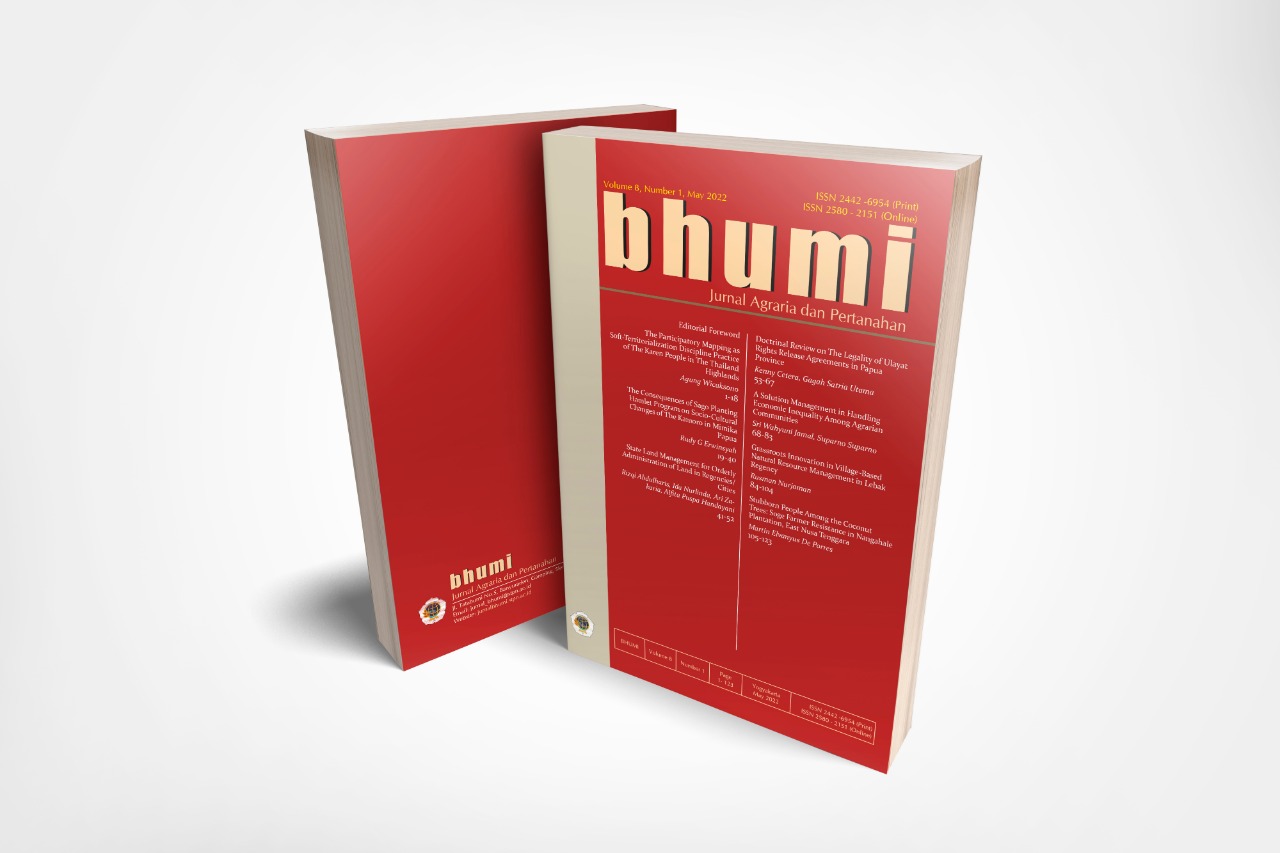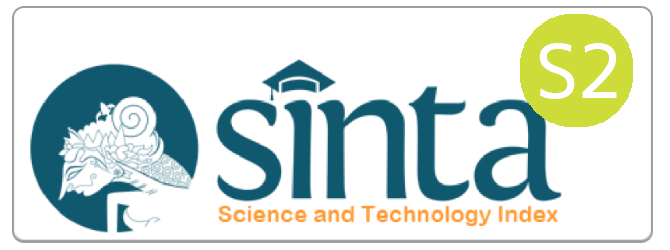The Consequences of Sago Planting Hamlet Program on Socio-Cultural Changes of The Kamoro in Mimika Papua
Abstract
This study examines the consequences of various agrarian policies and development programs on the Kamoro community in Mimika Regency, Papua Province. As a result of FI Mining activities, the Kamoro people, who were originally nomads on their customary lands, were relocated to permanent settlement where they were introduced to intensive farming systems, one of which was the Sago Planting Hamlet (SPH/DST) Program that brought modern sago farming management. There was a contradiction because the Kamoro people have been accustomed to rice as their staple for decades due to the national food policy during the New Order era and the damage to their ecological environment, especially wild sago forests. This study tries to see how the socio-cultural consequences in the community since the implementation of intensive agricultural programs are relatively new to them. Research question were answered through a descriptive qualitative approach, with primary data from in-depth interviews and participatory observations, supported by secondary data from the archive and document searches, also spatial data from Landsat imagery. The results showed that the implementation of the DST Program brought the consequences of socio-cultural changes to the Kamoro people, which included adjustments to social organization, livelihoods, and natural resource management. What happened to the Kamoro: the collapse of the production, reproduction, and consumption systems of society due to the alienation of traditional living cultures that rely on the availability of natural sources of livelihood, has made the Kamoro undeveloped.
Keywords: Intensive agriculture, Kamoro, sago plantations, socio-cultural changes
Downloads
References
Abbas, B. (2021). Adaptive Evolution and Addressing the Relevance for Genetic Improvement of Sago Palm Commodity. In Genetic Variation (Issue December). IntechOpen. https://doi.org/10.5772/intechopen.94395
Abdulgani, F. (2020). Sang Pemburu dalam Jerat Kerja Upahan: Investigasi Moda Produksi dalam Proses Industrialisasi Sagu di Papua Barat. Wacana: Jurnal Transformasi Sosial, 38, 51–102. https://insistpress.com/katalog/menegarakan-tanah-dan-darah-papua/
Banks, G. (2002). Mining and the environment in Melanesia: Contemporary debates reviewed. Contemporary Pacific, 14(1), 39–67. https://doi.org/10.1353/cp.2002.0002
Bantacut, T. (2011). Sagu: sumberdaya untuk penganekaragaman pangan pokok. Jurnal Pangan, 20(1), 27–40. https://doi.org/https://doi.org/10.33964/jp.v20i1.6
Barkan, J. (2013). Corporate Sovereignty: Law and Government under Capitalism. University of Minnesota Press. https://doi.org/10.5749/minnesota/9780816674268.001.0001
Bowen, J. R. (1986). On the Political Construction of Tradition: Gotong Royong in Indonesia. The Journal of Asian Studies, 45(3), 545–561. https://doi.org/10.2307/2056530
BPS. (2015). Konsumsi Kalori dan Protein Penduduk Indonesia dan Provinsi 2015. Badan Pusat Statistik.
BPS. (2019). Konsumsi Kalori dan Protein Penduduk Indonesia dan Provinsi 2019. Badan Pusat Statistik.
Brunskill, G. J., Zagorskis, I., Pfitzner, J., & Ellison, J. (2004). Sediment and trace element depositional history from the Ajkwa River estuarine mangroves of Irian Jaya (West Papua), Indonesia. Continental Shelf Research, 24(19), 2535–2551. https://doi.org/https://doi.org/10.1016/j.csr.2004.07.024
Denzin, N. K., & Lincoln, Y. S. (Eds.). (2005). The SAGE Handbook of Qualitative Research (3rd ed., Vol. 1, Issue 1). SAGE Publication. https://doi.org/10.1108/17465640610666642
Djoefrie, M. H. B., Herodian, S., Ngadiono, A. T., & Amarillis, S. (2014). Sagu untuk Kesejahteraan Masyarakat Papua: Suatu Kajian dalam Upaya Pengembangan Sagu sebagai Komoditas Unggulan di Provinsi Papua dan Provinsi Papua Barat. Unit Percepatan Pembangunan Papua dan Papua Barat.
Ellen, R. (2004a). Processing Metroxylon Sagu Rottboell (Arecaceae) as a Technological Complex: A Case Study from South Central Seram, Indonesia. Economic Botany, 58(4), 601–625. https://doi.org/http://dx.doi.org/10.1663/0013-0001(2004)058[0601:PMSRAA]2.0.CO;2
Ellen, R. (2004b). The distribution of Metroxylon sagu and the historical diffusion of a complex traditional technology. In P. Boomgaard & D. E. F. Henley (Eds.), Smallholders and Stockbreeders: History of Foodcrop and Livestock Farming in Southeast Asia (pp. 69–105). KITLV Press. https://doi.org/https://doi.org/10.1163/9789004487710_006
Ellen, R. (2006). Local knowledge and management of sago palm (Metroxylon sagu rottboell) diversity in south central Seram, Maluku, eastern Indonesia. Journal of Ethnobiology, 26(2), 258–298. https://doi.org/10.2993/0278-0771(2006)26[258:LKAMOS]2.0.CO;2
Erwinsyah, R. G. (2020). Orang Kamoro dalam Perubahan Agraria: Telaah terhadap Program Dusun Sagu Tanam di Kabupaten Mimika Provinsi Papua. Universitas Gadjah Mada.
Fenske, M., & Bendix, J. (2007). Micro, Macro, Agency: Historical Ethnography as Cultural Anthropology Practice. Journal of Folklore Research, 44(1), 67–99. https://doi.org/10.2307/4640221
Firdaus, R. S. M., & Wibowo, I. A. (2020). Demokrasi Ekonomi dan Industri Rakyat: Tawaran Jalan bagi Industri Sagu oleh Masyarakat Adat di Sorong Selatan, Papua Barat. Wacana: Jurnal Transformasi Sosial, 38, 133–170. https://insistpress.com/katalog/menegarakan-tanah-dan-darah-papua/
Hickey, S., & du Toit, A. (2013). Adverse Incorporation, Social Exclusion, and Chronic Poverty. In A. Shepherd & J. Brunt (Eds.), Chronic Poverty: Concepts, Causes and Policy (pp. 134–159). Palgrave Macmillan. https://doi.org/https://doi.org/10.1057/9781137316707_7
Hidayat, H., & Yamamoto, S. (2014). Papua’s threatened forests: conflict of interest government versus local indigenous people. South Pacific Studies, 34(2), 71–98.
Hisa, L., Mahuze, A., & Arka, I. W. (2019). Dokumentasi Etnobotani-Linguistik Tumbuhan Sagu: Laporan Awal dari Etnis Marori di Taman Nasional Wasur Merauke. Linguistik Indonesia, 35(2), 187–200. https://doi.org/10.26499/li.v35i2.69
Hoshour, C. A. (1997). Resettlement and the politicization of ethnicity in Indonesia. Bijdragen Tot de Taal-, Land- En Volkenkunde, 153(4), 557–576. https://doi.org/10.1163/22134379-90003915
IFACS. (2014). Rencana Konservasi Bentang Alam Kabupaten Mimika Provinsi Papua (Issue September). USAID Indonesia Forest and Climate Support.
Ito, T., Rachman, N. F., & Savitri, L. A. (2014). Power to make land dispossession acceptable: a policy discourse analysis of the Merauke Integrated Food and Energy Estate (MIFEE), Papua, Indonesia. The Journal of Peasant Studies, 41(1), 29–50. https://doi.org/10.1080/03066150.2013.873029
Jong, F. S. (2018). An Overview of Sago Industry Development, 1980s–2015. In H. Ehara, Y. Toyoda, & D. V. Johnson (Eds.), Sago Palm: Multiple Contributions to Food Security and Sustainable Livelihoods (pp. 75–89). Springer Singapore. https://doi.org/10.1007/978-981-10-5269-9_6
Jong, F. S., & Widjono, A. (2007). Sagu: Potensi Besar Pertanian Indonesia. Jurnal Iptek Tanaman Pangan, 2(1), 54–65.
Kusumaryati, V. (2020). Adat Institutionalisation, the State and the Quest for Self-Determination in West Papua. Asia Pacific Journal of Anthropology, 21(1), 1–16. https://doi.org/10.1080/14442213.2019.1670238
Larastiti, C. (2020). Sagu dan Krisis Reproduksi Sosial Orang Kaiso. Wacana: Jurnal Transformasi Sosial, 38, 103–132. https://insistpress.com/katalog/menegarakan-tanah-dan-darah-papua/
Leach, M., Mearns, R., & Scoones, I. (1999). Environmental entitlements: Dynamics and institutions in community-based natural resource management. World Development, 27(2), 225–247. https://doi.org/10.1016/S0305-750X(98)00141-7
Li, T. M. (2000). Articulating indigenous identity in Indonesia: Resource politics and the tribal slot. Comparative Studies in Society and History, 42(1), 149–179. https://doi.org/10.1017/S0010417500002632
Li, T. M. (2005). Transforming the Indonesian Uplands: Marginality, Power and Production. Routledge. https://doi.org/10.4324/9780203986127
Li, T. M. (2007). The Will to Improve: Govermentality, Development, and the Practice of Politics. Duke University Press. https://doi.org/10.1215/9780822389781
Limbongan, J. (2007). Morfologi Beberapa Jenis Sagu Potensial di Papua. Jurnal Litbang Pertanian, 26(1), 16–24.
Makur, M. (2010). Papua village places food hopes in sago. The Jakarta Post. https://www.thejakartapost.com/news/2010/09/16/papua-village-places-food-hopes-sago.html
McCarthy, J. F. (2010). Processes of inclusion and adverse incorporation: oil palm and agrarian change in Sumatra, Indonesia. The Journal of Peasant Studies, 37(4), 821–850. https://doi.org/10.1080/03066150.2010.512460
McCulloch, N., & Timmer, C. P. (2008). Rice Policy in Indonesia: A Special Issue. Bulletin of Indonesian Economic Studies, 44(1), 33–44. https://doi.org/10.1080/00074910802001561
McDonnell, J. E. (2021). The Merauke Integrated Food and Energy Estate (MIFEE): An Ecologically Induced Genocide of the Malind Anim. Journal of Genocide Research, 23(2), 257–278. https://doi.org/10.1080/14623528.2020.1799593
Merton, R. K. (1936). The Unanticipated Consequences of Purposive Social Action. American Sociological Review, 1(6), 894. https://doi.org/10.2307/2084615
Neilson, J., & Wright, J. (2017). The state and food security discourses of Indonesia: feeding the bangsa. Geographical Research, 55(2), 131–143. https://doi.org/10.1111/1745-5871.12210
Neuman, W. L. (2006). Basics of Social Research: Qualitative and Quantitative Approaches (2nd ed.). Pearson Education.
Panggabean, P. (2002). Pemberdayaan Sub Suku Nawaripi di Nayaro, Kabupaten Mimika, Papua melalui Program Rekognisi Tahun 1998-2001. Universitas Indonesia.
Paull, D., Banks, G., Ballard, C., & Gillieson, D. (2006). Monitoring the Environmental Impact of Mining in Remote Locations through Remotely Sensed Data. Geocarto International, 21(1), 33–42. https://doi.org/10.1080/10106040608542372
Persoon, G. (1998). Isolated Groups or Indigenous Peoples: Indonesia and the International Discourse. Bijdragen Tot de Taal-, Land- En Volkenkunde, 154(2), 281–304. https://doi.org/10.2307/27865431
Pouwer, J. (1970). Mimika Land Tenure. In M. W. Ward (Ed.), Land Tenure in West Irian (pp. 24–33). Research School of Pacific and Asian Studies, Australian National University. https://doi.org/10.1525/aeq.1971.2.2.05x0105a
Pouwer, J. (2010). Gender, Ritual and Social Formation in West Papua. KITLV Press. https://doi.org/10.1163/9789004253728
Powell-Davies, T. (2021). Sago Versus Rice and the Reorganisation of Ritual Spacetime: Competing Modes of Dependency in an Age of Decentralisation in Asmat, Indonesian Papua. Oceania, 91(2), 216–235. https://doi.org/10.1002/ocea.5306
PTFI. (n.d.). PT Freeport Indonesia - Economic Program. PT Freeport Indonesia. Retrieved April 12, 2021, from https://ptfi.co.id/en/economic-program
Rifai-Hasan, P. A. (2009). Development, Power, and the Mining Industry in Papua: A Study of Freeport Indonesia. Journal of Business Ethics, 89(S2), 129–143. https://doi.org/10.1007/s10551-010-0371-y
Sahlins, M. (1963). Poor man, rich man, big man, chief: Political types in Melanesia and Polynesia. Comparative Studies in Society and History, 5(3), 206–215. https://doi.org/10.4324/9781315063362-30
Sidiq, F. F., Coles, D., Hubbard, C., Clark, B., & Frewer, L. J. (2021). Sago and the indigenous peoples of Papua, Indonesia: A review. Journal of Agriculture and Applied Biology, 2(2), 138–149. https://doi.org/10.11594/jaab.02.02.08
Simanjuntak, A. H., & Erwinsyah, R. G. (2020). Kesejahteraan Petani dan Ketahanan Pangan pada Masa Pandemi Covid-19: Telaah Kritis terhadap Rencana Megaproyek Lumbung Pangan Nasional Indonesia. Sosio Informa, 6(2), 184–204. https://doi.org/10.33007/inf.v6i2.2332
Slikkerveer, L. J. (2019). Gotong Royong: An Indigenous Institution of Communality and Mutual Assistance in Indonesia. In L. J. Slikkerveer, G. Baourakis, & K. Saefullah (Eds.), Integrated Community-Managed Development: Strategizing Indigenous Knowledge and Institutions for Poverty Reduction and Sustainable Community Development in Indonesia (pp. 307–320). Springer. https://doi.org/10.1007/978-3-030-05423-6_14
Soares, A. de J. (2004). The Impact of Corporate Strategy on Community Dynamics: A Case Study of the Freeport Mining Company in West Papua, Indonesia. International Journal on Minority and Group Rights, 11(1–2), 115–142. https://doi.org/10.1163/1571811041631263
Somba, N. D. (2012). Papua shootings impede development process. The Jakarta Post. https://www.thejakartapost.com/news/2012/02/14/papua-shootings-impede-development-process.html
Spaargaren, G., & Mol, A. P. J. (1992). Sociology, environment, and modernity: Ecological modernization as a theory of social change. Society and Natural Resources, 5(4), 323–344. https://doi.org/10.1080/08941929209380797
Suparlan, P. (2001). Orang Kamoro: Perubahan Kehidupan dan Lingkungannya. Antropologi Indonesia, 24(64), 84–90. https://doi.org/10.7454/ai.v0i64.3411
Suryana, A. (2008). Menelisik Ketahanan Pangan, Kebijakan Pangan, dan Swasembada Beras. Pengembangan Inovasi Pertanian, 1(1), 1–16. http://www.pustaka.litbang.deptan.go.id/publikasi/ip011081.pdf
Tebay, L. (2003). Perubahan Lingkungan Hidup di Kawasan Pertambangan PT Freeport Indonesia (Studi tentang Adaptasi Masyarakat Amungme di Desa Harapan Kwamki Lama dan Masyarakat Kamoro di Desa Nayaro, Kabupaten Mimika, Provinsi Papua). Universitas Indonesia.
Tohari, A. (2013). Land Grabbing dan Potensi Internal Displacement Persons (IDP) dalam Merauke Integrated Food and Energy Estate (MIFEE) di Papua. Jurnal Bhumi, 37(12), 49–62. https://doi.org/https://doi.org/10.31292/jb.v0i37.151
Townsend, P. K. (2003). Palm Sago: Further Thoughts on a Tropical Starch from Marginal Lands. RMAP Working Papers, 49, 1–19. http://hdl.handle.net/1885/39954
Viartasiwi, N., Trihartono, A., & Yuswadi, H. (2018). The West Papua Imagined Community: A Bondless Plural Society. In B. McLellan (Ed.), Sustainable Future for Human Security: Society, Cities and Governance (pp. 79–99). Springer Singapore. https://doi.org/10.1007/978-981-10-5433-4_6
WALHI. (2006). Dampak Lingkungan Hidup Operasi Pertambangan Tembaga dan Emas Freeport-Rio Tinto di Papua. Wahana Lingkungan Hidup Indonesia.
Wardis, G. (2014). Socio-economic factors that have influenced the decline of sago consumption in small islands: a case in Rural Maluku, Indonesia. South Pacific Study, 34(2), 99–116.
Wibowo, A., Salleh, K. O., Frans, F. T. . S., & Semedi, J. M. (2016). Spatial Temporal Land Use Change Detection Using Google Earth Data. IOP Conference Series: Earth and Environmental Science, 47(1), 012031. https://doi.org/10.1088/1755-1315/47/1/012031
YPMAK. (2018). Lindungi Dusun Sagu Masyarakat. Yayasan Pemberdayaan Masyarakat Amungme Dan Kamoro. https://www.ypmak.or.id/2018/10/30/433/
Copyright (c) 2022 Rudy Gunawan Erwinsyah

This work is licensed under a Creative Commons Attribution-ShareAlike 4.0 International License.












